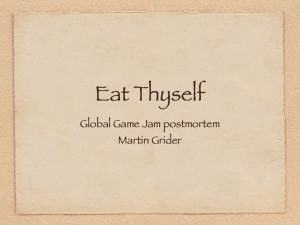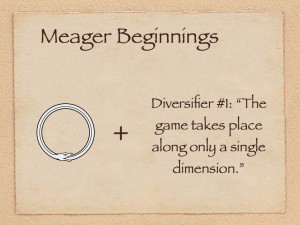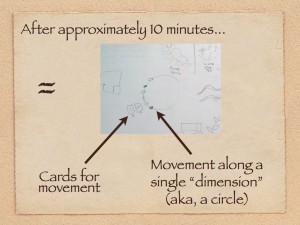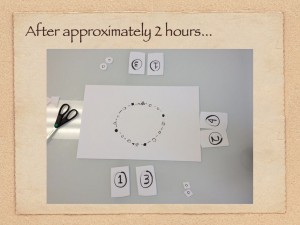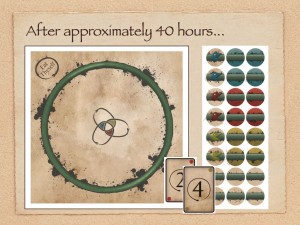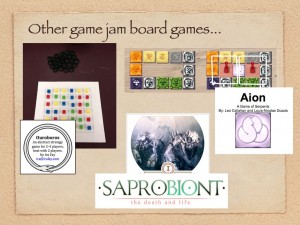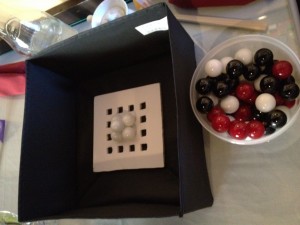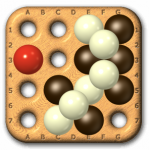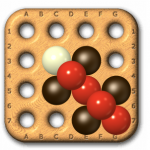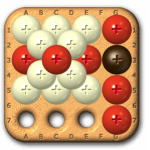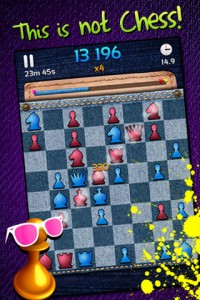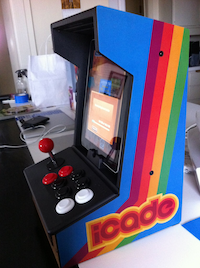After joining my fellow twin cities IGDA members at the global game jam a few weekends ago, I was all fired up about the board games that were made that weekend. In fact, I spent a good chunk of the following weekend going through all one hundred and two “non-digital” games in the Global Game Jam database from 2012. With the exception of a few that I skipped over categorically (mostly roll-and-moves, but I apologize if I missed any cool ones), this post contains my paring down of those hundred-plus games to just the English ones that are ready for print-and-play. Keep in mind that I would guess at least one-in-four had absolutely nothing on the game page at all other than a name and sometimes a description. There were also probably between three and ten that were just totally miss-categorized, as well as a similar number that weren’t written in English.
After doing all that research, I meant to post my thoughts on all these playable games ASAP, but it took me until tonight to find the time to sit down and actually do it. So without further ado, here is a list of all the games that, at the time of my research, had all the files and instructions necessary to play them available on the Global Game Jam website, along with some (brief) thoughts on each one.
First, there were fivefour games I managed to get to a playable state by our IGDA meetup:
- Eat Thyself – (printing requires color) – I would of course be remiss if I did not put my own project first. My friend and fellow board game designer August Brown did an absolutely fantastic job on the artwork for this, (and he wasn’t even signed up for the Game Jam!) I’m very excited to mount the board I’ve printed to posterboard sometime in the not-so-distant future. It’s an abstract strategy that plays 2 or 3 players in probably around ten minutes. I’m calling it a “light” abstract because there’s not a whole lot of brain burning. The game admittedly has some problems when played with 3 players, but I’ve got some ideas for fixing it, I just haven’t tested them yet, or posted them anywhere.
- Saprobiont – (requires color) – The artwork on this one is absolutely fantastic. It only plays with exactly four players, and each player has variable player abilities, and also score victory points (called biomass) in subtly different ways. It’s lightly war-game-ish, but with such simple (and balanced) combat that it feels more like an abstract strategy game. This game pretty much dominated our IGDA recap night, and was played at least five times in the course of the evening. I had someone ask me for advice about making their own copy a few days later. At least one of the creators is active on Board Game Geek, and has created an entry for Saprobiont there as well.
- Aion: A Game of Serpents – (requires color) – This two-player tile-laying game has extremely well designed rules, with lots of illustrations and examples. I am sad I didn’t get a chance to play the version I made for our meetup. I’m not even sure that anyone played it!
- Ouroboros – (B&W is probably fine) – This was actually the first of the GGJBGs that I played. Sunday afternoon, I was hanging around the Game Jam, watching everyone else frantically finish up while I wrote blog posts and read twitter. Eventually I got bored of that, and started surfing games on the Game Jam website that looked ready to play. This one jumped out at me because it was one of the only other games tagged “Abstract Strategy”. It was also playable with a pile of lego pieces (which I had on hand), and on a 6×6 gameboard I was able to draw in 10 seconds. I convinced another Jammer to play with me, and we were both quite impressed. Lots of thinking, and the game didn’t turn out at all the way we’d thought it was headed, so surprise twists at the end of the game are possible (not something I look for in an abstract, but it was refreshing at the time).
- Cult Wars – (B&W) – looks to be an interesting card game for 2 to 4 players, and it has absolutely fantastic black and white artwork. Unfortunately, I got the cards all printed and cut, and had everything ready to go before I really started looking into the rules. I think there is some clarification needed on some pretty major points. (For example, which cards do you start with, and which do you draw in the course of playing?) The rules need some major work, IMHO, and unfortunately, the game is not really “ready” to play without making some stuff up as you go.
Other games I believe are ready to play but that just didn’t make the cut in my first pass:
- Alpha & Omega – (requires color) – A tile laying game with player pawns that need to be positioned optimally for scoring at the end of the game. The rules PDF has some formatting issues, but I’m still interested, and would love to try it out sometime.
- destination earth – (B&W) – 2-player card game with science fiction theme. The hand-drawn art is pretty cool, but the cards look fairly dull to me. I really have no idea how it plays.
- Escape from Infinity – (requires color) – I noticed this game also has a BGG page now. This is a racing game… the innovation here is that before anyone moves, you choose a card for each player, and on your turn, you chose one of those players to move the number of spaces your card represents. Seems like there’s ample opportunity for screwage as well as nail biting as you hope so-and-so doesn’t screw up your card choices. When all the cards have moved, the round is over, and it all starts over again.
- floatsam – (B&W) – I didn’t quite understand the rules here at first pass. They probably deserve another look, but it’s somehow a “competitive maze game of skill and luck for 2-4 players”.
- The Frightening Temple Of Set – (requires color) – This game has a sweet looking hand-drawn gameboard. It’s a roll-and-move, but with some rather complex rules that might make it fun for a certain kind of person.
- Lines of Nazca – (requires color & Legos!) – I actually think this looks awesome. You construct a secret puzzle goal out of three lego pieces that you hide from everyone else and are trying to duplicate as you play the game. Meanwhile, you are also moving a pawn on the gameboard by playing lego pieces.
- Magnum Opus – (requires color) – Looks like another tile-laying game. I’d need to “dig in” before I truly understood this one, I think.
- Moebius slider – (B&W) – This incredibly simple dexterity game should have made “the cut”, but I just didn’t remember to make it at the very last minute.
- OUROBOTOS – (requires color) – You are assembling some kind of giant robot. How much cooler than that is even possible!?! Apparently there is resource management. I haven’t fully examined this one yet.
- Rapush – (technically not B&W, but looks to be okay with it) – This appears to be a pretty straight-forward abstract strategy game with the “pushing other people’s pieces” mechanic.
- Stranded – (B&W) – Interesting seeming card game with rather lackluster art. The game’s setup could use some additional explaining.
- tailbiter – (B&W) – I can’t quite tell if the very minimalist rule-set would be enough to grok this game. It sounds almost war-like.
- Your Genre Sucks – (technically needs color, but would probably work without – requires standard deck of cards) – Fairly interesting story-telling game where everyone plays with a different genre and must keep pulling the story back into their type of story.
Bonus Game!!!
- Obsolescence – (requires color) – This game wasn’t available when I did my earlier research, but I noticed it tonight, and am intrigued. Here’s the description the designers gave it: “Tile Laying game in which players develop, upgrade, and recycle successive generations of Apple gadgets by laying tiles representing components on a circuit board, connector edge to connector edge in order to form closed loops consisting of newly laid and previously laid components.” Sounds right up my alley, doesn’t it? I’ll have to try this out sometime soon.
- Entagon
- pandemonium
- Sugar Crush
- Cowroboros
- Blue Print
- Centrix
- Gaeon
- Goons & Guns
Honorable mentions list #1 (Games that would be cool, but look too hard to construct):
Honorable Mentions list #2: (Not all files are available, but would possibly be really cool if they were!):

